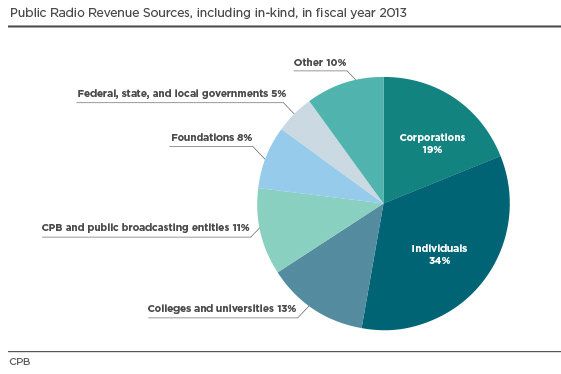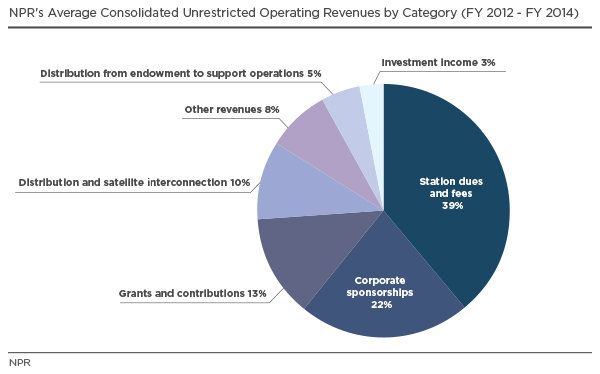PlayNow!No, I don't like the ads—er, the "enhanced sponsorship"—of PBS, NPR, PRI, or any of the other CPB TLA (Three Letter Acronyms, for those who haven't tripped on this trope before). But the other funding mechanisms employed also come with details worthy of attention, if not scorn.
Episode #28: Showing What The Shows Show uses three PBS telly shows to illustrate problems with three funding sources other than enhanced sponsorship.

 Pie Charts courtesy of L33t's link.
Pie Charts courtesy of L33t's link.I read in this episode from Thomas Picketty's
Capital in the Twenty-First Century (President and Fellows of Harvard College, 2014, pp. 451-452.); a Wikipedia article on the history of public broadcasting in the United States; Robert W. McChesney and John Nichols' book
The Death and Life of American Journalism: The Media Revolution That Will Begin the World Again (First Nation Books, 2010, p. 194 for "Banks And The Poor" details; p. 195 for the detail about fund raising.); and
the article "A Word From Our Sponsor?" from the May 27, 2013 New Yorker magazine.Music pulled from the Downton Abby Suite, and "The Money Song" by Monty Python.

 Pie Charts courtesy of L33t's link.
Pie Charts courtesy of L33t's link.
 Pie Charts courtesy of L33t's link.
Pie Charts courtesy of L33t's link.
Great episode!
ReplyDeleteI'm glad you focused on the substantial, on-topic part of my response. (As opposed to the surface reason why I was annoyed by your choice of metaphor, though I feel obligated to reiterate for other commenters: It wasn't because the metaphor was "extreme", mostly, I was annoyed because of how that choice of metaphor leaned on misogynistic tropes.)
You're right that both bias towards "the source of the money wants other people to see this" and bias towards "the source of the money wants to see this" are problems. (The "filter bubble" phenomenon is a little of both.)
Your hypothetical of having a third party anonymize donations would indeed be better, but it's not a complete solution. It's really, really easy for large donors to deanonymize their own donations, even without making any overt threat.
Foundations have the same problems as individual donors. Though with both there's a spectrum of bias. Some foundations (or individuals) are able to more credibly say that their support doesn't depend on the specifics of the content than others. Of course, there's always a chance that someone's stated-and-financially-demonstrated commitment to independent journalism will waver when you hit some issue that's a particular hot button for them.
Thanks, once again!
Delete. . . I was annoyed because of how that choice of metaphor leaned on misogynistic tropes.
I was concerned about this as well, and tried to keep the prostitute-as-sex-worker as gender neutral as possible. Specifically to avoid this problem, back in the original episode I had some material in Susan's script that included priests in the Fellatio Booth that didn't make it past the editing process. I agonized about cutting it, but due to a weak script it just didn't fit.
Your filter bubble link was interesting, but didn't address the reason the filters were first installed: the ad problem. Typical. I hope to cover the filter bubble problem in a future episode, of course. Loved Pariser's book.
I mentioned the problem with large donors specifically (of course) to point out the obvious stuff you mentioned and to use the reference in a future episode about public media funding.
Damn, but I do that a lot. I've had this whole ad thing stuck in my head so long I've developed a narrative that I forget is not shared by anyone else. I guess it's good I'm doing the 'cast: it allows me to flesh out this internal narrative, check for any glaring errors. As listeners, though, you guys must be frustrated with the loose threads I haven't noted are going to be tied eventually.
I'll give this problem some thought.
And speaking of thoughts, please keep them coming and by doing so keeping me on the ball!